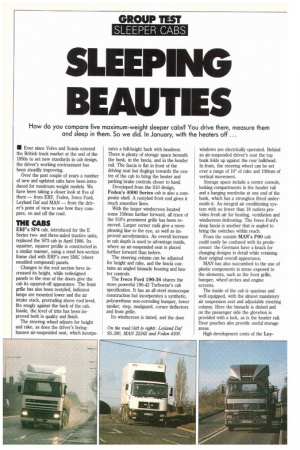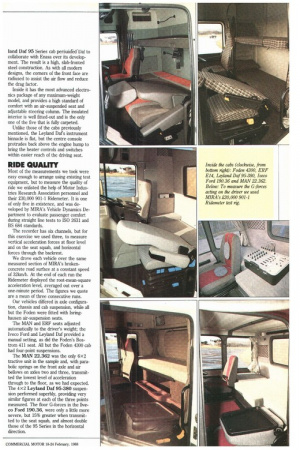SLEEPING BEAUTIES
Page 38

Page 39

If you've noticed an error in this article please click here to report it so we can fix it.
• Ever since Volvo and Sc,ania entered the British truck market at the end of the 1950s to set new standards in cab design, the driver's working environment has been steadily improving.
Over the past couple of years a number of new and updated cabs have been introduced for maximum weight models. We have been taking a closer look at five of them — from ERF, Foden, Iveco Ford, Leyland Daf and MAN — from the driver's point of view to see how they compare, on and off the road.
ERF's SP4 cab, introduced for the E Series twoand three-axled tractive units, replaced the SP3 cab in April 1986. Its squatter, squarer profile is constructed in a similar manner, using a steel box-section frame clad with ERF's own SMC (sheet moulded compound) panels.
Changes to the roof section have increased its height, while redesigned panels to the rear of the doors give the cab its squared-off appearance. The front grille has also been restyled, indicator lamps are mounted lower and the air intake stack, protruding above roof level, fits snugly against the back of the cab. Inside, the level of trim has been improved both in quality and finish.
The steering wheel adjusts for height and rake, as does the driver's Isringhausen air-suspended seat, which incorpo rates a full-height back with headrest. There is plenty of storage space beneath the bunk, in the fascia, and in the header rail. The fascia is flat in front of the driving seat but doglegs towards the centre of the cab to bring the heater and parking brake controls closer to hand.
Developed from the S10 design, Foden's 4000 Series cab is also a composite shell. A restyled front end gives it much smoother lines.
With the larger windscreen located some 150rnm further forward, all trace of the SlO's prominent grille has been removed. Larger corner radii give a more pleasing line to the eye, as well as improved aerodynamics. An overall increase in cab depth is used to advantage inside, where an air-suspended seat is placed further forward than before.
The steering column can be adjusted for height and rake, and the fascia contains an angled binnacle housing and heater controls.
The Iveco Ford 190-36 shares the more powerful 190-42 Turbostar's cab specification. It has an all-steel monocoque construction but incorporates a synthetic, polyurethane non-corroding bumper, lower spoiler, step, mudguard, corner deflectors and front grille.
Its windscreen is tinted, and the door windows are electrically operated. Behind an air-suspended driver's seat the top bunk folds up against the rear bulkhead. In front, the steering wheel can be set over a range of 100 of rake and 100mm of vertical movement.
Storage space include a centre console, locking compartments in the header rail and a hanging wardrobe at one end of the bunk, which has a strongbox fitted underneath it. An integral air conditioning system with no fewer than 18 outlets provides fresh air for heating, ventilation and windscreen defrosting. The Iveco Ford's deep fascia is another that is angled to bring the switches within reach.
From the outside MAN's F90 cab could easily be confused with its predecessor: the Germans have a knack for changing designs in detail while retaining their original overall appearance.
MAN has also succumbed to the use of plastic components in areas exposed to the elements, such as the front grille, bumper, wheel arches and engine screens.
The inside of the cab is spacious and well equipped, with the almost mandatory air suspension seat and adjustable steering column. Here the binnacle is dished and on the passenger side the glovebox is provided with a lock, as is the header rail. Door pouches also provide useful storage areas.
High development costs of the Ley land Daf 95 Series cab perSualfed-Daf to collaborate with Enasa over its development. The result is a high, slab-fronted steel construction. As with all modern designs, the corners of the front face are radiused to assist the air flow and reduce the drag factor.
Inside it has the most advanced electronics package of any maximum-weight model, and provides a high standard of comfort with an air-suspended seat and adjustable steering column. The insulated interior is well fitted-out and is the only one of the five that is fully carpeted.
Unlike those of the cabs previously mentioned, the Leyland Dafs instrument binnacle is flat, but the centre console protrudes back above the engine hump to bring the heater controls and switches within easier reach of the driving seat.
Most of the measurements we took were easy enough to arrange using existing test equipment, but to measure the quality of ride we enlisted the help of Motor Industries Research Association personnel and their 230,000 901-1 Ridemeter. It is one of only five in existence, and was developed by MIRA's Vehicle Dynamics Department to evaluate passenger comfort during straight line tests to ISO 2631 and BS 684 standards.
The recorder has six channels, but for this exercise we used three, to measure vertical acceleration forces at floor level and on the seat squab, and horizontal forces through the backrest.
We drove each vehicle over the same measured section of MIRA's brokenconcrete road surface at a constant speed of 32km/h. At the end of each run the Ridemeter displayed the root-mean-square acceleration level, averaged out over a one-minute period. The figures we quote are a mean of three consecutive runs.
Our vehicles differed in axle configuration, chassis and cab suspension, while all but the Foden were fitted with Isringhausen air-suspension seats.
The MAN and ERF seats adjusted automatically to the driver's weight; the Iveco Ford and Leyland Daf provided a manual setting, as did the Foden's Bostrom 411 seat. All but the Foden 4300 cab had four-point suspensions.
The MAN 22.362 was the only 6x2 tractive unit in the sample and, with parabolic springs on the front axle and air bellows on axles two and three, transmitted the lowest level of acceleration through to the floor, as we had expected. The 4x2 Leyland Daf 95-380 suspension performed superbly, providing very similar figures at each of the three points measured. The floor G-forces in the Iveco Ford 190.36, were only a little more severe, but 15% greater when transmitted to the seat squab, and almost double those of the 95 Series in the horizontal direction.
























































































